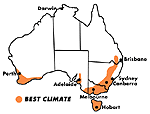Not all Australian native plants are worth growing. Don looked at a lovely native tree which has become a weed.
Plant details
Common names: Native daphne, sweet pittosporum, mock orange, native laurel
Botanic name: Pittosporum undulatum
Description: A tall shrub or small tree to about 12m (40′) tall. The leaves are dark green and glossy with wavy margins, and are best recognized by lines of brown blisters along the leaf-surface which are caused by leaf miners. In spring large terminal bundles of creamy white fragrant flowers appear, followed by small orange-red berries, each containing 20-25 sticky orange-red seeds.
Climate and weed potential:
This plant is native to eastern Australia, where it grows in rainforest, wet and dry sclerophyll forest and woodland. However, it has become a weed in all states of Australia except for the Northern Territory. It is adaptable to a range of acid soils, and is hardy to frost and drought. It will grow in either full sun or part shade.
The berries of the native daphne are eaten and spread by birds such as pied currawongs, and the seeds germinate very easily. It is an opportunistic, aggressive coloniser of disturbed areas enriched by run-off, and outcompetes other native plants. It should not be planted in areas close to bushland. Also, keep an eye on areas where pittosporum may colonise (such as areas where gardens adjoin the natural bush). If pittosporum is growing, it can be removed using bush regeneration methods and replanted with other native plants from the local area.



